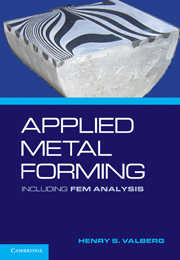Book contents
- Frontmatter
- Contents
- Preface
- APPLIED METAL FORMING
- 1 Characteristics of Metal Forming
- 2 Important Metal Forming Processes
- 3 FEA of Metal Forming
- 4 Theory
- 5 Reduction and Proportions of the Plastic Zone
- 6 Deformations from the Velocity Field
- 7 Technological Tests and Physical Simulation
- 8 Flow Stress Data
- 9 Formability and Workability
- 10 Friction and Friction Models
- 11 Thermal Effects
- 12 Experimental Metal Flow Analysis
- 13 Theoretical Methods of Analysis
- 14 Finite Element Analysis
- 15 FEA of Technological Tests
- 16 Forging
- 17 FEA of Forging
- 18 Extrusion
- 19 FEA of Extrusion
- 20 Rolling
- 21 FEA of Rolling
- 22 Drawing of Wire, Profiles, and Tubes
- 23 FEA of Wiredrawing
- 24 Sheet-Metal Forming
- Index
- References
10 - Friction and Friction Models
Published online by Cambridge University Press: 05 June 2012
- Frontmatter
- Contents
- Preface
- APPLIED METAL FORMING
- 1 Characteristics of Metal Forming
- 2 Important Metal Forming Processes
- 3 FEA of Metal Forming
- 4 Theory
- 5 Reduction and Proportions of the Plastic Zone
- 6 Deformations from the Velocity Field
- 7 Technological Tests and Physical Simulation
- 8 Flow Stress Data
- 9 Formability and Workability
- 10 Friction and Friction Models
- 11 Thermal Effects
- 12 Experimental Metal Flow Analysis
- 13 Theoretical Methods of Analysis
- 14 Finite Element Analysis
- 15 FEA of Technological Tests
- 16 Forging
- 17 FEA of Forging
- 18 Extrusion
- 19 FEA of Extrusion
- 20 Rolling
- 21 FEA of Rolling
- 22 Drawing of Wire, Profiles, and Tubes
- 23 FEA of Wiredrawing
- 24 Sheet-Metal Forming
- Index
- References
Summary
In metal forming, friction is a crucial factor that determines whether an industrial process can be run with acceptable, economic result. In many forming applications, the actual friction conditions are not sufficiently known. In spite of much research on that important topic, there is still lack of knowledge and need for continued research.
This chapter will first explain why friction is so important in metal forming. Then the two most-applied friction models will be presented, and the characteristic of each model will be explained and discussed. Afterwards the most common lubrication mechanisms that may be present in the interface between die and workpiece will be described. Moreover, it will be explained how relevant metal forming friction data can be measured by the ring compression test. Finally, it will be shown how in situ friction measurements can be performed inside a die during the course of forming, using pins inserted into holes drilled into the tooling.
Friction Effects in Metal Forming
The friction phenomenon in metal forming is of great importance. There are various reasons for this:
Forming loads and stresses transferred to the dies depend on friction and can be reduced by use of appropriate lubricants.
The surface quality of the formed workpiece depends on the lubricant used. If there is lubricant breakdown during forming, the product may obtain bad surface quality (for instance, scoring).
Wear of the dies can be reduced if lubricant films are applied, which provide reduced friction, or even full or partial separation, between the die and the workpiece during forming.
- Type
- Chapter
- Information
- Applied Metal FormingIncluding FEM Analysis, pp. 139 - 158Publisher: Cambridge University PressPrint publication year: 2010
References
- 1
- Cited by



